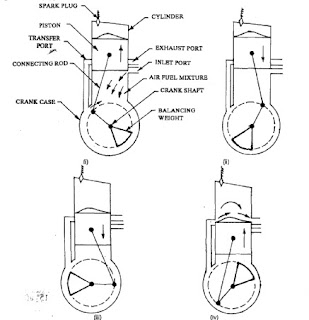The classification of petrol engines on the arrangement of cylinder is as follows.
1. Inline arrangement – 2 in line, 3 inline, 4 inline, 6 inline and 8 inline.
2. V arrangement – v-4, v-6, v-8 and v-12.
3. Opposed cylinder or flat arrangement – flat 2, flat 4 and flat 6.
4. Radial cylinder arrangement.
Construction and working of 2 Stroke and 4 stroke engines Two Stroke engine:
The two stroke engine there are two strokes namely upward stroke and downward stroke. In a two stroke engine, the two strokes are completed in two strokes of the piston or one complete revolution of the crankshaft. Upward stroke: during the upward stroke the piston moves upward from bottom dead centre to top dead centre. The air fuel mixture or air is compressed in the combustion chamber of the cylinder. Due to upward movement of the piston, a partial vacuum is created in the crankcase, and a new charge is drawn into the crankcase through the uncovered inlet port. The exhaust port and transfer port are covered when the piston is at top dead centre position. The compressed charge is ignited in the combustion chamber.
Downward stroke: As soon as the charge is ignited, the hot gases compress the piston which moves downward, rotating the crankshaft thus doing the useful work. During this stroke the inlet port is covered by the piston and the new charge is compressed in the crankcase. Further downward movement
of the piston uncovers first the exhaust port and then the transfer port, and hence the exhaust starts through the exhaust port. As soon as the transfer port opens, the charge through it is forced into the cylinder. The charge strikes the deflector on the piston crown, rises to the top of the cylinder and pushes out most of the exhaust gases. The piston is now at bottom dead centre position. The cylinder is completely filled with the fresh charge, although it is then repeated, the piston making two strokes for each revolution of the crankshaft.

No comments:
Post a Comment